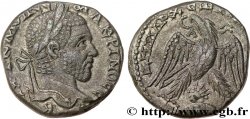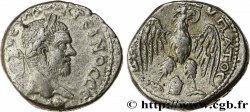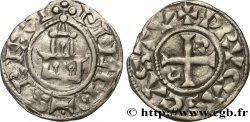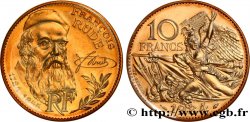bpv_173688 - MACRINUS Tétradrachme syro-phénicien
Nicht verfügbar.
Artikel auf unserem Online-Shop verkauft (2014)
Preis : 350.00 €
Artikel auf unserem Online-Shop verkauft (2014)
Preis : 350.00 €
Type : Tétradrachme syro-phénicien
Datum: 217-218
Name der Münzstätte / Stadt : Hiérapolis, Syrie, Cyrrhestica
Metall : Scheidemünze
Durchmesser : 25 mm
Stempelstellung : 11 h.
Gewicht : 11,18 g.
Seltenheitsgrad : R1
Kommentare zum Erhaltungszustand:
Très mauvais centrage et flan oblong, très beau portrait bien en relief
N° im Nachschlagewerk :
Vorderseite
Beschreibung Vorderseite Buste de Macrin à droite, lauré et drapé, vu de trois-quarts en avant, les deux rubans pendant derrière la tête (A*01).
Legende des Averses AUT K. M. OPEL... SE. MAKREINOS SE, (Autokratoros Kaisaros Markos Opellios Seuhros Makrinos Sebastos)
Übersetzung der Vorderseite (L’empereur césar Marc Opel Sévère Macrin auguste).
Rückseite
Beschreibung Rückseite Aigle debout à gauche, ailes écartées, la tête et la queue à droite, tenant une couronne feuillée dans son bec ; entre les pattes, un lion passant à droite.
Legende des Reverses : DHMARC. EX. UPATOS
Übersetzung der Rückseite (Revêtu de la puissance tribunitienne consul).
Kommentare
Les frappes de Macrin à Hiérapolis sont assez nombreuses mais bien inférieures à celles de Caracalla et de Diaduménien, dont c’est l’atelier le plus productif, devant même Antioche.
On repère deux graveurs de droit et plusieurs graveurs de revers, une étude des liaisons de coins serait certainement instructive sur la structure de l’émission.
Hiérapolis, "la ville du Soleil" où se trouvait le temple d'Astarté construit par Séleucos Ier Nicator, l'actuelle Manbidj, était située près de l'Euphrate entre Berœa (Alep) à l'ouest et Carrhæ (Harran) à l'Est sur la route des caravanes aux portes de la province de Mésopotamie en Syrie Cyrrhestica.
HIérapolis est un atelier important pour Caracalla mais, curieusement, avec une production concentrée sur le type à droite, drapé et cuirassé, toutes les autres variantes étant frappées en quantités minimes.
L’attribution est certaine : le graveur spécifique à l’atelier se retrouve sur la frappe de présentation avec Hadad et Atargatis trônant avec le semeion, type qui ne peut qu’être attribué à Hiérapolis. La frappe de présentation porte aussi un petit aigle et le symbole du lion passant, aucun doute n’est donc possible.
On notera sur certaines représentations un lion d’une taille relativement importante et d’une qualité de gravure tout à fait remarquable. Il existait probablement encore des lions vivant à l’état sauvage à cette époque dans la région, également des réserves de chasse (paradeisos) où l’artiste a pu observer parfaitement le modèle.
On note que les sigma sont gravés en C.
Dans la base TSP maintenue par Michel Prieur, seize exemplaires sont maintenant répertoriés. Cet exemplaire, qui provient de la trouvaille dite de Syrie 1930, est le 0943_003.
The strikes of Macrinus at Hierapolis are quite numerous but much inferior to those of Caracalla and Diadumenian, of which it is the most productive workshop, even ahead of Antioch..
We can identify two obverse engravers and several reverse engravers; a study of the die links would certainly be instructive on the structure of the issue..
Hierapolis, \\\"the city of the Sun\\\" where the temple of Astarte was located, built by Seleucus I Nicator, modern Manbij, was located near the Euphrates between Berœa (Aleppo) to the west and Carrhae (Harran) to the east on the caravan route to the gates of the province of Mesopotamia in Syria Cyrrhestica.
Hierapolis is an important mint for Caracalla but, curiously, with production concentrated on the right-hand type, draped and cuirassed, all other variants being struck in minimal quantities.
The attribution is certain: the specific engraver of the workshop is found on the presentation strike with Hadad and Atargatis enthroned with the semeion, a type which can only be attributed to Hierapolis. The presentation strike also bears a small eagle and the symbol of the lion passant, so there is no doubt.
We will note on certain representations a lion of a relatively large size and of a quite remarkable quality of engraving. There were probably still lions living in the wild in the region at that time, as well as hunting reserves (paradeisos) where the artist was able to observe the model perfectly..
Note that the sigmas are engraved in C.
In the TSP database maintained by Michel Prieur, sixteen examples are now listed. This example, which comes from the so-called Syria 1930 find, is 0943_003
On repère deux graveurs de droit et plusieurs graveurs de revers, une étude des liaisons de coins serait certainement instructive sur la structure de l’émission.
Hiérapolis, "la ville du Soleil" où se trouvait le temple d'Astarté construit par Séleucos Ier Nicator, l'actuelle Manbidj, était située près de l'Euphrate entre Berœa (Alep) à l'ouest et Carrhæ (Harran) à l'Est sur la route des caravanes aux portes de la province de Mésopotamie en Syrie Cyrrhestica.
HIérapolis est un atelier important pour Caracalla mais, curieusement, avec une production concentrée sur le type à droite, drapé et cuirassé, toutes les autres variantes étant frappées en quantités minimes.
L’attribution est certaine : le graveur spécifique à l’atelier se retrouve sur la frappe de présentation avec Hadad et Atargatis trônant avec le semeion, type qui ne peut qu’être attribué à Hiérapolis. La frappe de présentation porte aussi un petit aigle et le symbole du lion passant, aucun doute n’est donc possible.
On notera sur certaines représentations un lion d’une taille relativement importante et d’une qualité de gravure tout à fait remarquable. Il existait probablement encore des lions vivant à l’état sauvage à cette époque dans la région, également des réserves de chasse (paradeisos) où l’artiste a pu observer parfaitement le modèle.
On note que les sigma sont gravés en C.
Dans la base TSP maintenue par Michel Prieur, seize exemplaires sont maintenant répertoriés. Cet exemplaire, qui provient de la trouvaille dite de Syrie 1930, est le 0943_003.
The strikes of Macrinus at Hierapolis are quite numerous but much inferior to those of Caracalla and Diadumenian, of which it is the most productive workshop, even ahead of Antioch..
We can identify two obverse engravers and several reverse engravers; a study of the die links would certainly be instructive on the structure of the issue..
Hierapolis, \\\"the city of the Sun\\\" where the temple of Astarte was located, built by Seleucus I Nicator, modern Manbij, was located near the Euphrates between Berœa (Aleppo) to the west and Carrhae (Harran) to the east on the caravan route to the gates of the province of Mesopotamia in Syria Cyrrhestica.
Hierapolis is an important mint for Caracalla but, curiously, with production concentrated on the right-hand type, draped and cuirassed, all other variants being struck in minimal quantities.
The attribution is certain: the specific engraver of the workshop is found on the presentation strike with Hadad and Atargatis enthroned with the semeion, a type which can only be attributed to Hierapolis. The presentation strike also bears a small eagle and the symbol of the lion passant, so there is no doubt.
We will note on certain representations a lion of a relatively large size and of a quite remarkable quality of engraving. There were probably still lions living in the wild in the region at that time, as well as hunting reserves (paradeisos) where the artist was able to observe the model perfectly..
Note that the sigmas are engraved in C.
In the TSP database maintained by Michel Prieur, sixteen examples are now listed. This example, which comes from the so-called Syria 1930 find, is 0943_003








 Berichten über einen Fehler
Berichten über einen Fehler Die Seite drucken
Die Seite drucken Teilen meiner Auswahl
Teilen meiner Auswahl Stellen Sie eine Frage
Stellen Sie eine Frage Einlieferung/Verkauf
Einlieferung/Verkauf
 Details
Details















